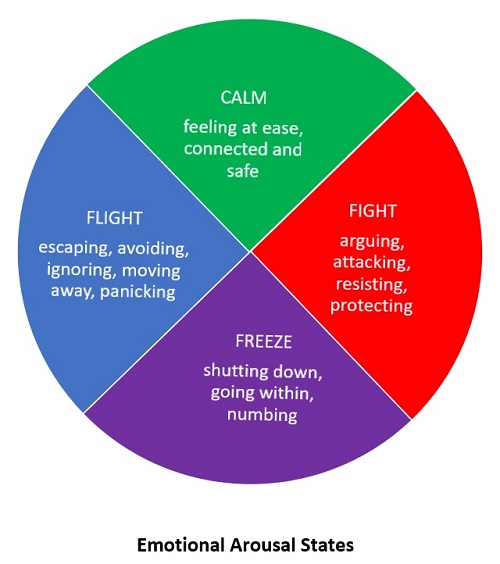Responding Based on Emotional States
by Kathy Slattengren, M. Ed., Priceless Parenting (sign up for monthly parenting newsletter and receive 20+ printable charts for kids and parents)
(listen to article read by the author)

Recognizing emotional states is key to good communication. You need to know both your own emotional state and the emotional state of others. This would be a lot easier if people’s emotional states weren’t constantly changing!
Have you ever had a terrible morning because your child became upset over something? Perhaps your child felt rushed, couldn’t find the completed homework or didn’t want to go to school. Situations like these can spiral downwards quickly as tempers flare.
If you don’t recognize your child is not in a calm state, you can accidentally add more stress. It’s especially easy to ignore or misread your child’s emotions if you are not in a calm state yourself.
Recognizing Emotional States
There are four basic emotional arousal states: calm, fight, flight or freeze. When you are feeling safe and at ease, you are in a state of calm. This is the state that is optimal for learning and for communicating. You’ll do your best parenting when you are calm.
When you or your children feel threatened or disconnected, you enter a state of fight, flight or freeze (FFF). These are some physical symptoms of the FFF alarm state:
- fast, shallow breaths
- heart beating faster
- face getting red
- cold hands
- dry mouth
- stomach hurting
- sweating
- trembling
- pupils dilating to increase focus, losing peripheral vision
- feeling dizzy or lightheaded
If you notice that you are in the FFF state, try returning to a calm state before responding to your kids. You may need to tell them that you are angry and need time to yourself before you can talk to them. This will allow you to avoid saying or doing something you’ll later regret.
Responding When Your Child Is Upset
You know your children are in an FFF state if they are yelling, sobbing, kicking, hitting, hiding or giving a blank look. How you respond at this point will either help them move towards a calm state or further escalate them.
What helps your child move back towards a calm state? It might be taking some deep breaths together, rubbing your child’s back, leaving your child alone for a while or listening to your child.
What is likely to further escalate your child? Your child is likely to become more upset if you yell, criticize, lecture or tell them to calm down. It is easy to respond in ways that accidentally add fuel to the fire.
Claire found this out one morning with her 10-year-old son, Eli. Their family rule is no screens before 7:00 AM. However, Claire saw Eli using his Nintendo Switch at 6:45 AM. She told him he couldn’t use it anymore that morning since he broke the rule.
She then asked him if he did his 20 minutes of reading last night. Eli admitted he had not read. Claire reminded him just because it doesn’t need to be turned in, he still needs to do it. He grumbled and muttered under his breath then started reading.
At 7:55 AM Eli told his mom he was meeting friends at 8:05 to walk to school. She asked him to clear the table and fill the dog’s bowls before he left. He was rushing around getting dressed and preparing his backpack. As he was about to leave, she stopped him to point out his dishes were still on the table and the dog bowls were empty. He said he didn’t have time.
She told him he needs to manage his time better. She said she’d take care of the tasks since he was running late now. Eli yelled while racing over to fill the dog’s bowls and stomping to the table to clear the dishes. He stormed out of the house without acknowledging her good-bye. Claire was confused as to why Eli was getting angry so quickly lately.
Can you relate to how both Claire and Eli were feeling? By the end, neither one was calm. When do you think Eli moved from calm to an FFF state? Perhaps when he was caught breaking the screen time rule. Reminding him of his failure to read, clear his dishes and fill the dog bowls escalated his feelings.
Exploring Other Responses
What might have worked better in Claire and Eli’s situation? When Claire told Eli that he couldn’t use his Nintendo Switch more that morning, what would have changed if she then listened to his response? He might have come up with an excuse for having it before 7:00, complained about the rule or apologized. Claire can listen without needing to back down on the rule. By listening and staying close to him, she could reassure him of her love regardless of his mistake.
If Claire realized Eli was in an FFF state, she also might have decided to approach the other issues differently. Eli is likely to respond better if he feels his mom is on his side trying to help him. She might ask Eli what all he needs to get done before leaving for school. Perhaps he agrees to clearing his breakfast dishes and feeding the dog plus doing an extra 20-minutes of reading after school.
The key to getting your child back to calm is to be calm yourself. You can take some deep breaths with your child. You can listen and hold space for their strong emotions. You can be the rock they can hold on to while they steady themselves and regain their calm.